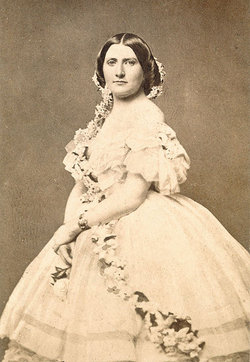Harriet Lane Johnston (Harriet Lane Johnston)

Harriet Lane’s family was from Franklin County, Pennsylvania. She was the youngest child of Elliott Tole Lane, a merchant, and Jane Ann Buchanan Lane. She lost her mother when she was 9; when her father’s death 2 years later made her an orphan, she requested that her favorite uncle, James Buchanan, be appointed her legal guardian. Buchanan, an unmarried Democratic senator from Pennsylvania, indulged his niece and her sister, enrolling them in boarding schools in Charles Town, Virginia (later for two years at the Academy of the Visitation Convent in the Georgetown section of Washington, D.C.) By this time, Buchanan was Secretary of State, and he introduced her to fashionable circles as he had promised. In 1854 she joined him in London, where he was minister to the Court of St. James’s. Queen Victoria gave “dear Miss Lane” the rank of ambassador’s wife; admiring suitors gave her the fame of a beauty. In appearance “Hal” Lane was of medium height, with masses of light, almost golden-colored hair.
The capital welcomed its new “Democratic Queen” to the White House in 1857. Harriet was a popular hostess during the four years of the Buchanan presidency. Women copied her hair and clothing styles (especially when she lowered the neckline on her inaugural gown by 2.5 inches), parents named their daughters for her, and a popular song (“Listen to the Mockingbird”) was dedicated to her. While in the White House, she used her position to promote social causes, such as improving the living conditions of Native Americans in reservations. She also made a point of inviting artists and musicians to White House functions. For both her popularity and her advocacy work, she has been described as the first of the modern first ladies, and her popularity at the time is compared to that of Jacqueline Kennedy in the 1960s. The presidential yacht was named for her—the first of several ships to be named for her, one of which is still in service today.
As sectional tensions increased, she worked out seating arrangements for her weekly formal dinner parties with special care, to give dignitaries their proper precedence and still keep political foes apart. Her tact did not falter, but her task became impossible—as did her uncle’s. Seven states had seceded by the time Buchanan retired from office and returned with his niece to his spacious country home, Wheatland, near Lancaster, Pennsylvania.
From her teenage years, the popular Miss Lane flirted happily with numerous men, calling them “pleasant but dreadfully troublesome”. Buchanan often warned her against “rushing precipitately into matrimonial connections”, and she waited until she was almost 36 to marry. She chose, with her uncle’s approval, Henry Elliott Johnston, a Baltimore banker. Within the next 18 years she lost her uncle, both her young sons, and her husband.
Thereafter she decided to live in Washington. She had acquired a sizable art collection, largely of European works, which she bequeathed to the government. Accepted after her death in 1903, it inspired an official of the Smithsonian Institution to call her “First Lady of the National Collection of Fine Arts”. In addition, she dedicated a generous sum to endow a home for invalid children at the Johns Hopkins Hospital in Baltimore. It became a renowned pediatric facility; the Harriet Lane Outpatient Clinics serve thousands of children today, and the widely used manual for pediatric house officers, The Harriet Lane Handbook, bears her name.
Harriet wrote her will in 1895 and lived another eight years, during which the country’s general prosperity greatly increased the value of her estate. She added a codicil in 1899 directing that a school building be constructed on the grounds of the Washington National Cathedral property and asked that it be called the Lane-Johnston Building “to the end that the family names of my husband and myself may be associated with the bequest made in loving memory of our sons.” A codicil of 1903 increased her gift by one third but said that only half the total was to be spent on the building. The remainder was “specially to provide for the free maintenance, education and training of choirboys, primarily those in service of the Cathedral.” This bequest founded the prestigious boys’ school that today is called St. Albans School, which opened in October 1909.
At Harriet Lane Johnston’s funeral, services were conducted by Bishop Satterlee and Canon DeVries of the Washington National Cathedral. She was buried in Green Mount Cemetery, Baltimore, Maryland, her grave marked with a Celtic cross like the Peace Cross on the cathedral close. In 1905, guests were summoned to see the cornerstone of the first St. Albans School building, laid for what the invitation referred to as “The Lane Johnston Choir School for Boys of the Washington Cathedral”.
Born
- May, 09, 1830
- USA
- Mercersburg, Pennsylvania
Died
- July, 03, 1903
- USA
- Narragansett Pier, Rhode Island
Cemetery
- Green Mount Cemetery
- Baltimore, Maryland
- USA


